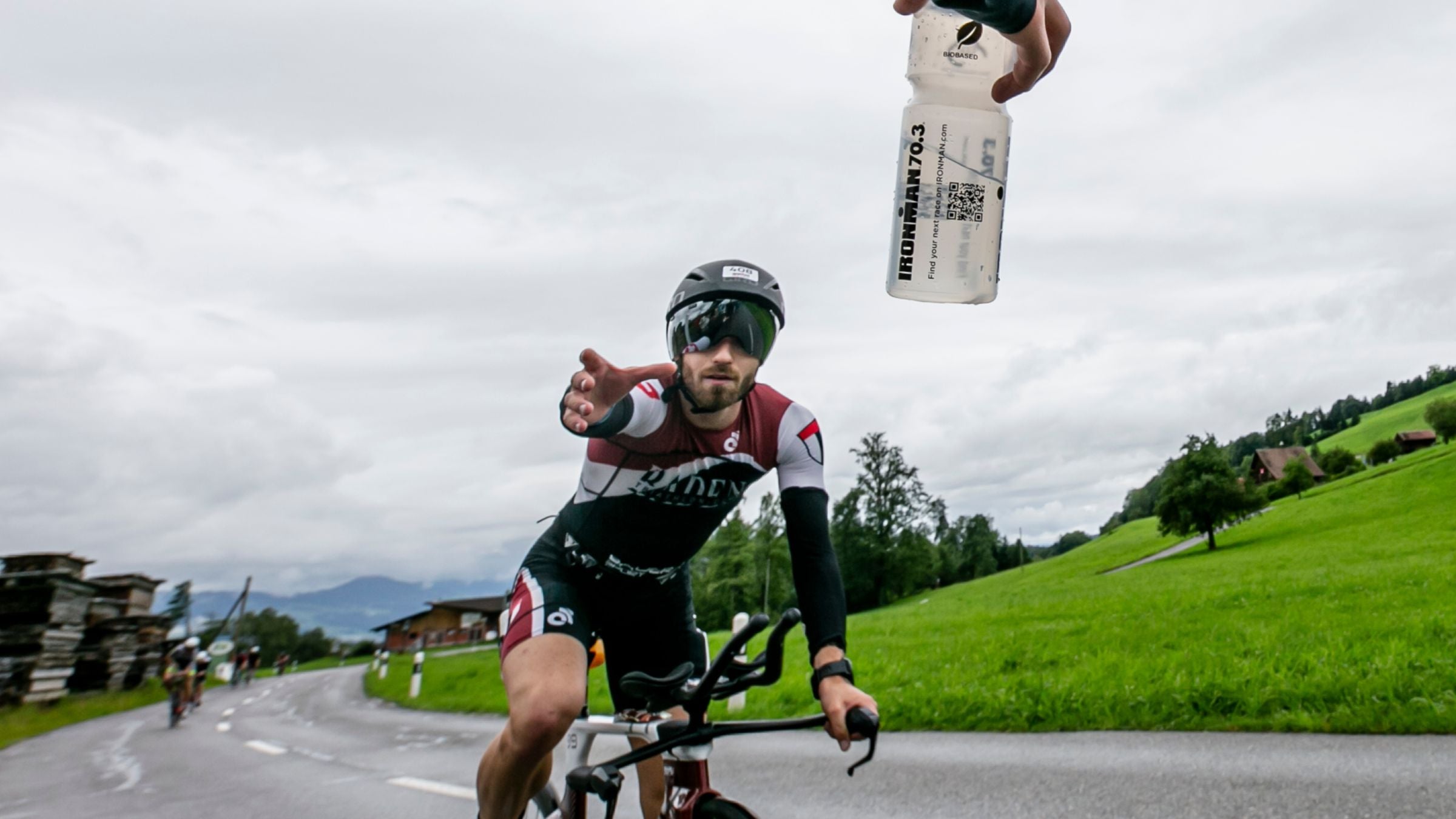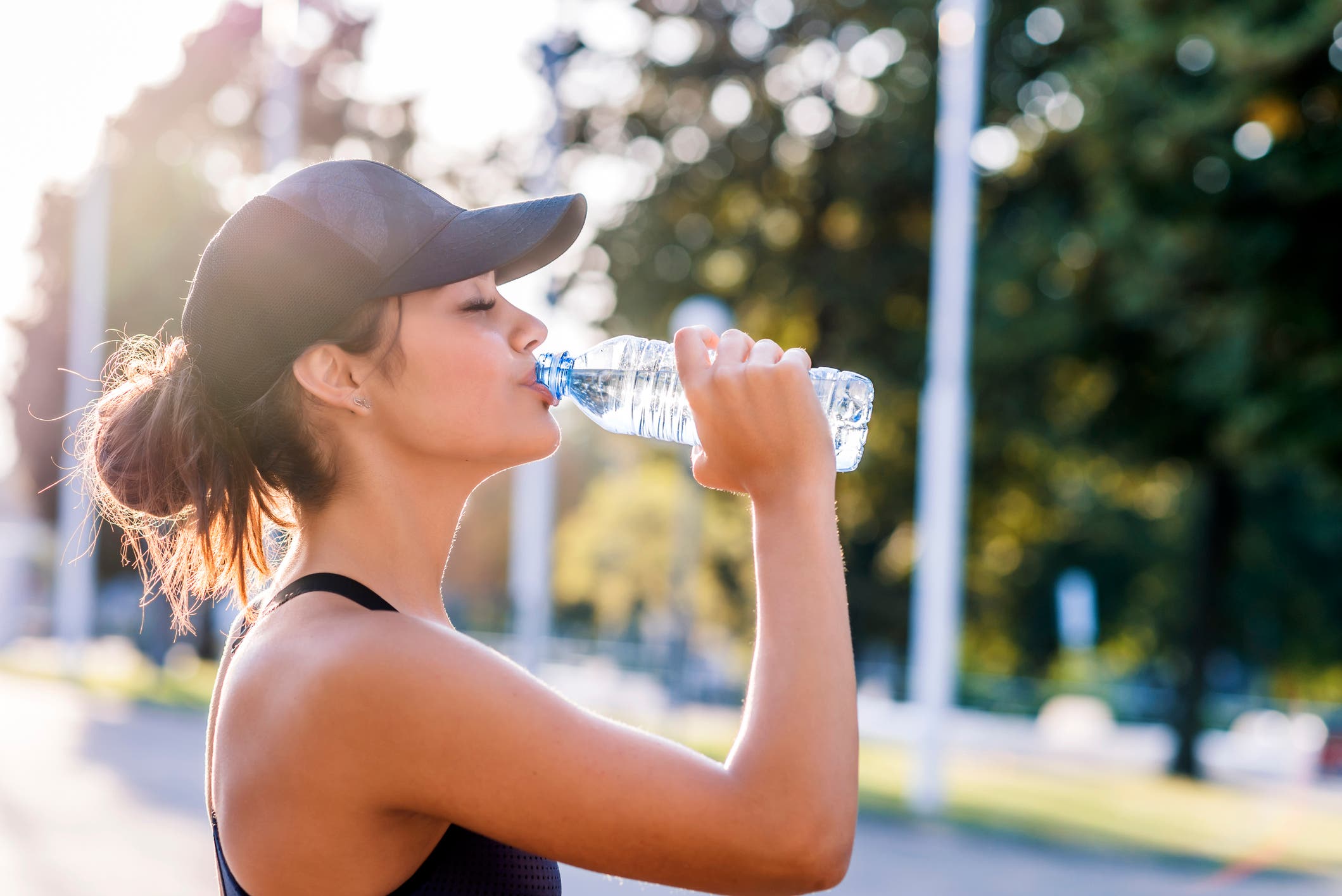Ask Stacy: Should I Be Worried About Hyponatremia?

(Photo: Jan Hetfleisch/Getty Images)
“Hyponatremia” is a word many athletes encounter when reading about fueling strategies, especially those racing longer events like 70.3 or Ironman. It sounds scary, and it can be. Hyponatremia should absolutely be avoided in a race, but perhaps not in the way you might think. Let’s talk about exercise-associated hyponatremia and what triathletes need to know.
Understanding exercise-associated hyponatremia
Hypo= low, natremia = sodium. “Hyponatremia” means that the sodium level in the blood is below normal, usually occurring when water and sodium are out of balance. Usual blood sodium levels are between 135 to 145 milliequivalents per liter (mEq/L), and if it falls below the 135 mEq/L mark, it is hyponatremia. In hyponatremia, one or more factors — ranging from an underlying medical condition to drinking too much water — cause the sodium in your body to become diluted. When this happens, your body’s water levels rise, and your cells begin to swell. This swelling can cause many health problems, from mild to life-threatening.
What we often hear about in the sporting circles is “exercise-associated hyponatremia” or EAH. EAH is defined by an acute fall in the serum or plasma sodium concentration to below 135 mEq/L that occurs during or up to 24 hours after prolonged physical activity. EAH has been reported in nearly every form of endurance activity and the underlying commonality is excessive intake of plain water, and is usually accompanied by an elevated level of the hormone vasopressin; which is the hormone responsible for fluid retention.
Men, women, and hyponatremia risk
We know that women are at greater risk for EAH. Initially, this increased risk was thought to be due to a lower body weight and size coupled with excessive water intake and longer race times as compared to men. However, these factors do not fully explain why there is a greater incidence of hyponatremia in women in endurance sport. The menstrual cycle comes into play, as greater levels of estrogen in plasma and/or tissue also play a role in retaining fluid and progesterone alters plasma sodium levels, which contribute to the increased risk of hyponatremia in women. Regardless of menstrual cycle phase, women have a post-exercise increase in plasma volume coupled with a decreased plasma sodium concentration as compared to age-and fitness-matched men; meaning that men will finish long distance exercise with normal to elevated blood sodium levels, but women tend to finish with normal to low blood sodium levels.
So, does this mean women should be ultra-concerned with developing hyponatremia? The short answer is No. What it does mean is re-evaluating drinking strategies for women and men for ultra-distance racing.
RELATED: How Sweat and Hydration Needs Differ for Men and Women

What you’re getting wrong about hydration and hyponatremia
Prior to 1981, endurance athletes were advised not to drink during exercise, which in some cases led to hypernatremia (high blood sodium levels). Due to this, the American College of Sports Medicine (ACSM) recommended to drink as much as possible during exercise to prevent hypernatremia. This advice led to an increased number of cases of EAH, especially in the USA. One major reason for this development was the misconception in sport science research that dehydration was the main cause of muscle cramping and gut distress, therefore athletes should aim to drink as much as possible in order to avoid dehydration, which was measured by a loss in body mass during exercise. We now know that this causes excessive water overload as many athletes drink fluids that are too dilute (plain water or carb-heavy, sodium light commercial sports drinks). In response to this, the mantra then became “drink to thirst”, which is not without its own issues, primarily ignoring the biochemical changes which occur after ~90minutes of exercise, muting thirst sensation and making drink to thirst an unreliable strategy to follow with regards to avoiding thermoregulatory challenges in longer exercise sessions.
RELATED: Are You Doing Thirst Right? The Science Says Probably Not
Let’s unpack this a bit. Hyponatremia results from a dilution of a normal or slightly reduced total extracellular sodium concentration due to a loss of sodium via sweat and urine. During exercise, there may be a large loss of sodium and fluid through urine and sweat (and rarely, vomiting). When fluid is replenished with a sodium-free solution or hypotonic fluid, such as water, so that the extracellular fluid volume either remains the same or increases, hyponatremia will result from dilution.
The bias and underlying assumption is that athletes are not drinking the right solutions, ingesting too little sodium and too much water. But hold those salt tablets! During exercise, low sodium intake alone does not seem to affect the risk of hyponatremia as much as fluid over-drinking. However, low dietary sodium intake for 10 days before a race can cause reductions in plasma sodium concentration, which in conjunction with fluid losses and high fluid consumption may lead to adverse effects during the race.
How to reduce the risk of developing hyponatremia in a race
Okay, then, how do we reduce the risk of developing hyponatremia on race day?
First and foremost, it is a rare occurrence to fall into hyponatremia if you have a tried and true drinking strategy – one that encourages sipping across the duration of a race to reduce overconsumption of fluids. The goal of fluid intake is to slow the rate of dehydration, but not stop dehydration. This fluid needs to have some sodium in it: the consensus is 230-690mg per liter.
RELATED: How Much Salt Do You Need While Training and Racing?
Next, ditch the salt tablets! Sodium intake during exercise will not prevent EAH in the presence of over-drinking/fluid overload, and excessive sodium intake may actually increase the risk of EAH due to the inappropriate response of fluid balance hormones. It is the amount of fluid, not the amount of sodium consumed, during exercise that increases final blood sodium concentrations.
It is the amount of fluid, not the amount of sodium consumed, during exercise that increases final blood sodium concentrations.
Be sure to salt your food and do not limit sodium intake in the week or so leading up to your race. Also, do not try to “hyperhydrate” with water in the days leading up to your race, especially the day before your race. This will reduce your body’s sodium stores, and contribute to EAH risk.
If you have had a previous episode of EAH, you may suffer from Syndrome of Inappropriate Antidiuretic Hormone Secretion; a condition where your body will over secrete vasopressin, increasing water retention. In this, it is very important to have a strategy for sipping fluids (not plain water!) along the way and avoiding over-drinking.
When it is hot and humid, it is important to stay on top of your fluid intake, but to not overcompensate. Around 20% of Kona Ironman athletes finish with EAH but only 30% of those needed clinical treatment. By altering your fluid intake to slow the rate of dehydration, (not trying to match sweat losses of water and sodium) through small intake and not overconsumption (especially plain water!) you will significantly reduce your risk for developing EAH. Along those same lines, understand that sodium intake in food and fluid helps with the sodium-fluid exchanges happening in your body during exercise but sodium/electrolyte tablets can exacerbate your risk of developing EAH.
Planning your nutrition should be simple: drink small amounts of sodium-containing fluid across the hour, each hour of racing; and eat sodium-containing foods across the race. Ditch the salt tablets and the concept of drinking to match sweat losses. These simple strategies will keep EAH at bay and get you to the finish line without a medical tent visit!
RELATED: The Fine Art (and Science) of Fueling for Hot Races